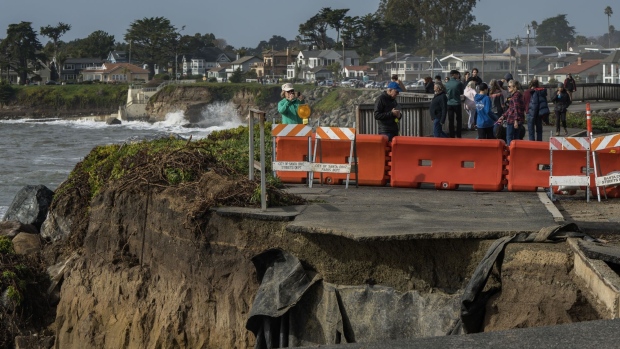Jan 9, 2023
California’s Week Starts With More Flooding, Mud and Outages
, Bloomberg News

(Bloomberg) -- After years of drought, California is in a long flood fight as waves of storms roll in off the Pacific, killing at least 14 people, closing highways up and down the state and sending residents fleeing for their lives.
Wind gusts exceeding 60 miles (97 kilometers) per hour are expected into Tuesday morning across mountains and foothills, National Weather Service’s Los Angeles office said on Twitter. Rain will be heavy at times and there’s also a risk of thunderstorms. More downed trees and powerlines should be expected, the forecaster said.
The parade of storms since the end of December is one of the biggest tests yet for disaster-weary California, which has endured a crucible of wildfires and extreme heat in recent years as global warming makes weather ever-more extreme.
On Monday residents in the tony coastal enclave of Montecito, home to Oprah Winfrey, Ellen DeGeneres and Prince Harry, were told by state officials in a tweet to “LEAVE NOW” while shelter-in-place orders were issued in other parts of Santa Barbara County. Several other towns throughout the state advised residents to get out before more rivers flood.
“California is experiencing coincidentally a drought emergency and a flood emergency,” said Department of Water Resources Director Karla Nemeth during a media briefing Monday.
Read: California town that’s home to Oprah and Prince Harry evacuated
Highway 1, pathway to the state’s renowned coastal area of Big Sur, was closed following a mudslide, according to the California Department of Transportation website. Parts of Highway 101 and Interstate 505 were also shut as of 4 p.m. local time.
They’re just a few of several major thoroughfares and small country roads closed because of flooding, from the state capital of Sacramento in the north to the garlic capital of Gilroy near Silicon Valley to Los Angeles-area beach towns in the south.
By 4 p.m. local time Monday the state had opened a dozen emergency shelters for those told to evacuate, including in Santa Cruz County, about 75 miles south of San Francisco, where the San Lorenzo River rose 17.7 feet (5.4 meters) since Sunday. Levels on the river probably have peaked but there will be another round of intense rain, said Daniel Swain, a climatologist at the University of California, Los Angeles.
Sacramento County on Sunday told about 3,300 people in the Central Valley town of Wilton ahead of Monday’s deluge to evacuate due to the risk of flooding if levies overflow, said county spokesperson Matt Robinson. Many downed trees are being removed to clear roads, he added.
Five rivers are being monitored for flooding including the Cosumnes River in Sacramento County and the Russian River in Napa and Mendocino counties in Northern California, according to Jeremy Arrich, flood management manager of the Department of Water Resources, said during the press briefing.
Heavy rain started falling Sunday night in many regions. About 179,000 customers were without power as of 2:47 a.m. in Los Angeles, according to PowerOutage.us. That’s down from more than 500,000 on Sunday after an earlier storm over the weekend.
The new storm may dump 2 to 5 inches (5 to 13 centimeters) of rain in some areas and 1 to 4 feet of snow in the Sierra Nevada, a mountain range in Eastern California, said Ashton Robinson Cook, a forecaster with the US Weather Prediction Center. Wind gusts may reach upwards of 50 miles per hour in many places.
Avalanche warnings have been posted in a number of areas through the Sierra Nevada through Wednesday, according to the National Weather Service. “Any steep slopes could be dangerous,” the weather service said.
Read also: California faces weeks of rain, thanks to system stuck in sky
The storm is another in a series of atmospheric river events, long streams of moisture that can stretch for thousands of miles across the Pacific and then deliver as much water as flows through the mouth of the Mississippi River when they’re wrung out on California’s mountains. The storms already have caused more than $1 billion in losses and damages, according to an estimate by AccuWeather Inc.
--With assistance from Brian Eckhouse, Dan Murtaugh and Lars Paulsson.
(Updates to include latest NWS notice in second paragraph.)
©2023 Bloomberg L.P.





